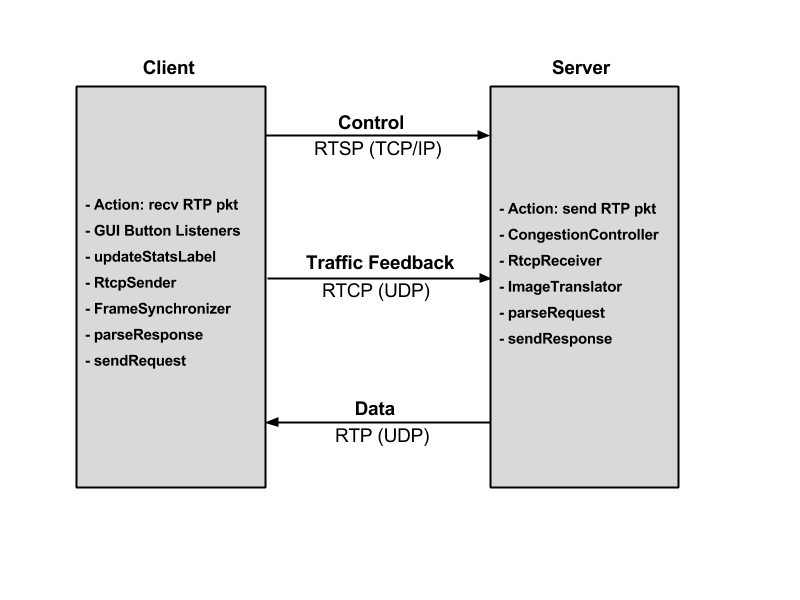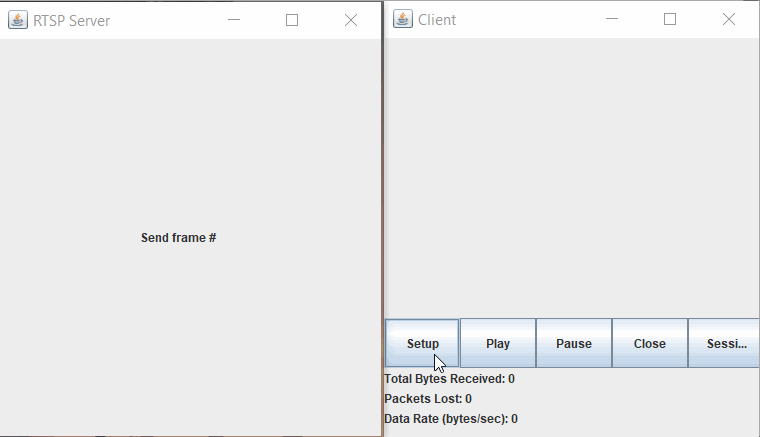RTSP-Client-Server
Introduction
Streaming videos are ubiquitous in the web today. The internet, originally designed for simple text/document based transfers using protocols such as the HTTP, is the platform on which streaming media is passed from one end of the world to another. In order to stream data across networks efficiently, the layers of the network stack must be enhanced with capabilities to transfer it efficiently while not congesting the network as a whole. This project examines how media can be transmitted over the network using Real Time Streaming Protocol (RTSP) and Real-time Transport Protocol (RTP/RTCP).
Architecture
This project uses a client-server architecture. Although RTP is a scalable protocol that could be extended to large scale with many senders and receivers, for simplicity we will be working with a single receiver/sender unicast model. The server is responsible for fetching a video file (whose name is provided by the client’s request) locally and passing it a frame at a time to the client. The client can make requests to the server via the RTSP protocol, which specifies the kinds of actions that the client can request the server to take on the stream, i.e. play, pause, stop, etc. Quality of service information can be fed back to the server from the client that sends packets following the RTCP protocol. Since RTP is an application layer protocol, it can be built on top of TCP/IP or UDP. Because TCP often comes with large overhead (due to its own congestion control mechanisms), we pick the minimal weight UDP protocol and handle congestion control using RTCP packets.

Design and Implementation
In addition to having the basic funtionality of the RTSP and RTP protocols, there are also implementation of support for Session Statistics, RTSP request method DESCRIBE and performance optimizations using traffic control mechanisms. Here we will discuss each of these components in more detail.
For providing statistical feedback to the client, I have created a set of labels in the user GUI to show the statistics on:
- Number of bytes received from client over the entire session
- The fraction of packets that was lost over the entire session
- Video data rate on the current session
To calculate the number of bytes received, an accumulator variable is defined in the class and gets incremented by the length of every new packet received over UDP. The fraction of packets lost is based on 2 other parameters: the cumulative lost packets and the total number of expected packets. The cumulative lost packets variable is incremented every time the sequence number of a packet is found to be different from the expected sequence number. The expected packets is based on the highest number received (in cases where some packets are lost and seqnum is larger than the counting number). The video data rate is based on the total of number of bytes received described earlier. This rate is calculated based on the time where the movie is actually playing and does not count time when the movie is paused. The client measures the interval between each received packet and sums them up to find the total time the movie is playing. This is then used for calculating the overall data rate statistic.
The DESCRIBE RTSP method is sent directly via the same connection that was
established for RTSP requests. It simply makes the request using the same method
that was used to make other RTSP requests such as SETUP and PLAY. A new response
parsing function is implemented since the response message format for DESCRIBE
is different than the others. The DESCRIBE request is made with the accepted
file type to be appliation/sdp, so we are expecting an SDP formatted string in
the body of the response message. On the server side, methods have been added
to handle an incoming DESCRIBE request. The response will be created in SDP format
following the SDP specifications. The following information is provided back to
the requester:
- RTSP port of the server
- Video encoding of the video transmitted over RTP
- RTSP ID of the established session
In the client GUI a "Session" button have been created so the user can test the DESCRIBE method functionality. You should see printout to stdout of the response coming back from the server when the Session button is clicked. Note that in order to use Session method the SETUP request must have been called already so the server is in INIT state.
Server and client both contain optimizations and traffic control mechanisms. The
framework providing communication between client and server on QoS data is the
RTCP protocol described under RFC 1889. For this I created a new class called
RTCPpacket that represents a RTCP packet. Specifics can be found on the RFC. The
RTCP protocol is built on top of the UDP transport protocol to have minimal overhead.
The amount of RTCP packets send via UDP is much less than RTP to minimize traffic. On
the server side, the class responsible for congestion control is CongestionController.
It periodically checks the statistics feedback from client (via RTCP packets) and
adjusts the rate to send RTP packets to the client. Congestion level is divided
into 4 levels from 1 to 4 represented by the congestionLevel variable, with 0
being not congested. Calculations on the congestion level are determined primarily
by the fractionLost field in the RTCP packet sent by the client.
In addtion to Congestion Control, the server side also provides adaptive video
compression/encoding to optimize the size of video frames to send to the client
under heavy traffic conditions. The ImageTranslator class does the job of compressing
a video frame bitstream into a lower quality. By sacrificing a lower quality video,
smaller packets are being sent over the wire and thereby reduces the congestion
in the network.
On the client side, the class FrameSynchronizer is created to solve the problem
of organizing frames that was sent over out of order sequence numbers. It achieves
this by using a buffer and keeps track of the expected sequence number versus
the actual sequence number received. If there is a discrepancy, it buffers the
frame and fills the gap with copies of the old frame that was last shown. The
algorithm in this Synchronizer solves the problem of the FunkyServer class, see
below section.
FunkyServer
The problem with FunkyServer is that it sends old frames intermittently. As an example, the sequence number it sends to the client would be:
348, 349, 350, 351, 352, 308, 308, 308, 308, 308, 308, 359
See that it replaced frames between frames 352 and 359 with 308. The client program
has a class FrameSynchronizer that will fix this problem. Because a video
should not "go back in time", i.e go from 352 to 308, the appropriate frame numbers
to show the audience in the above example should be:
348, 349, 350, 351, 352, 352, 352, 352, 352, 352, 352, 359
FrameSynchronizer will buffer frames and check for incoming sequence number. If
they are out of sync, it copies the latest frame and fills in the gap in the missed
frames. That way the video would just "freeze" and not have the "go back in time"
effect.
Main
Both server and client each contain a main method and should be executed separately on a server machine and client machine. Or they could both be executed on the same machine but running in separate processes.
Running Client/Server Programs
First, compile all *.java files, please use the makefile provided. Run the following
commands in bash to compile the java source code (tested with java version 1.8):
$ make
To re-build, run make clean to remove all class files first.
After compiling the files, simply type the following commands to run each program:
$ ./run_server # run the server
$ ./run_client # run the client
$ ./run_funky # run the funky server (copy FunkyServer class files from extras/ before running this)
Note that the client and server are assumed to be running on the same computer
i.e. localhost. By default, server ip address is localhost and port number is 1051. If for some reason any of these parameters need to be changed, simply open
the run_* files and modify the address and port variables.
Demo

Licensing
Copyright 2016 Dewei Chen
Licensed under the Apache License, Version 2.0 (the "License"); you may not use this file except in compliance with the License. You may obtain a copy of the License at http://www.apache.org/licenses/LICENSE-2.0
Unless required by applicable law or agreed to in writing, software distributed under the License is distributed on an "AS IS" BASIS, WITHOUT WARRANTIES OR CONDITIONS OF ANY KIND, either express or implied. See the License for the specific language governing permissions and limitations under the License.
